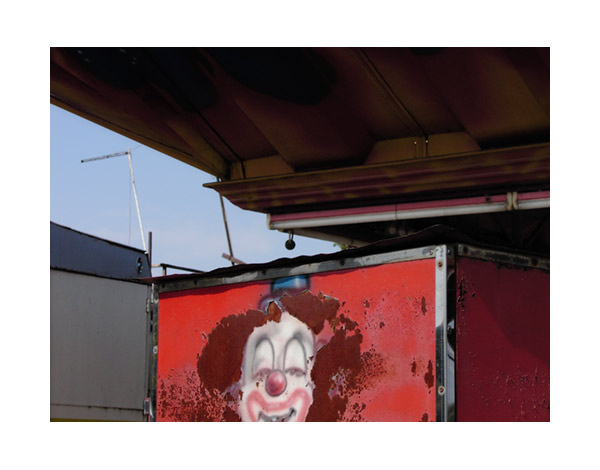lundi 3 juin 2024
lundi 18 juin 2018
DEZEEN.COM
 |
| Ajouter une légende |
mardi 12 mars 2013
My Portrait photographs website
Didier Gaillard-Hohlweg's
Portrait photographs website
jeudi 15 novembre 2012
Link to my Documentary Projects on issue.com
jeudi 5 juillet 2012
Gerültülü Duvarlar
Solo Exhibition
at Chalabi Art Galerie
Istanbul - Nişantaşı
Chalabi Art Gallery
Istanbul - Nişantaşı
Nietzsche’nin Şen Bilim kitabındaki “Deli” adındaki hikayede delinin biri pazar yerine dalar ve “Tanrı’yı arıyorum!” diye haykırır. Kendini ve kasaba halkını Tanrı’yı öldürmekle suçlayarak sorar: ” Bunu nasıl yapabildik? Denizi nasıl oldu da içip kurutabildik? Ufku silip atalım diye kim verdi elimize bezi? Dünyanın zincirini güneşten koparıp da ne yaptık? O şimdi nereye gidiyor? Biz nereye gidiyoruz? Devamlı batıp çıkıyor muyuz? Arkaya, yana, öne, her yöne? Aşağı veya yukarı diye bir şey kaldı mı? Sonsuz bir yoklukta sürüklenip durmuyor muyuz? Boşluğun nefesini duymuyor muyuz? Tanrılar da çürür. Ve O’nu biz öldürdük. Dünyanın şimdiye dek sahip olduğu en kutsal ve en güçlü şeyi bıçakladık ve ölümüne kanattık. Üstümüzdeki kanı kim silecek? Hangi su arındıracak bizi? Hangi kefaret törenlerini, hangi dini merasimleri icat edeceğiz. Yaptığımızın büyüklüğü bize biraz büyük değil mi?
Didier Gaillard-Hohlweg’in fotoğrafçılığı bizleri unutulmuş ütopyaların unutulmuş aşamalarına götürüyor. Bunlar, savaş, güç, diktatörlük ve yıkım ütopyaları. Yarısı kırılmış tabelalar, amacı çoktan unutulmuş afişlerde yırtık çocuk yüzleri, lunaparkın girişine boyanmış bir palyaço, unutulmuş bir zaman ve mekanın yadigarı. Herkes gitmiş. Öldürülmüş, yerinden edilmiş, geriye acizliğimizin ve kabullenişimizin şahidi toz katmanları ve molozla dolu, terk edilmiş mekanların hatırası kalmış. Gaillard-Hohlweg solgun ışıkta saydam anlam katmanlarından mekanlar yaratmakta. Kimi zaman uhrevi, bu mekanlar sanatın resmi unsurları olan çizgi, biçim ve kompozisyon çalışmaları yanında yerleştirmenin gerçekliği arasında akıp gitmekteler. Bir çitin güzel deseninin yanında aynı zamanda kimleri dışarıda bıraktığını görmek mümkün. Hafızalarının coğrafyasından kaçamayan yüzeylere suretinin çarpıcı gölgesini yansıtan güneş ışınları romavari revakların arasından akıp giderken Nürnberg’deki Reichsparteitag alanı. Hatıralarda kalmış terk edilmiş mekanlar, kendi elleri ile yok edilmiş, üzerlerini şimdiki zaman örtmüş, geçmekte olan devirler. Canlıyken hiç de şeffaf olmayan bu diktatorya oyun alanları Gaillard-Hohlweg’in merceğinden geçince saydamlaşıyor. Yakalayıp gösterdiği tahribat insanın insanla olanının yanında, doğa ile güçlü yapıların arasındaki savaşa ait. Doğanın sürekli yenilenme, çöküş, yenilenme şeklinde devam eden acımasız döngüsü. Gaillard-Hohlweg’in yakaladığı cansız imgeler -eskiyip çürümekten başka şansları olmayan terk edilmiş insan yapısı binalar, nöbet kuleleri, uçaklar- doğanın zaferini doğruluyor. Tabiatın karşısında eli kolu bağlanmışlar, bize deli adamın hikayesinin sonunu hatırlatıyorlar, elindeki feneri yere fırlattıktan sonra “aslında erken geldiğini” söyleyen deli diyor ki, “Hala devam etmekte insanların kulaklarına daha çalınmamış bu muazzam olay. Şimşek ve gök gürültüsü zaman ister, yıldızların parıltısı ve yapılmamış ameller de; olmuş olsalar bile, görülüp duyulana kadar zaman gerekir. Bu amel en uzak yıldızlardan bile daha uzak.” Gaillard-Hohlweg’in fotoğrafları bize gerçeği gösteriyor ve yaptıklarımızın ve yanlışlarımızın korkutucu manzarası ile daha yapılmamış olanın güzelliği arasındaki çelişkiyi hatırlatıyor.
Emily Phillips, Mart 2009
Her hakkı saklıdır.
Sanatçının Websitesi : https://issuu.com/didiergaillard-hohlweg
Çeviren : Zeynep İşgüder Hein
Dider Gaillard-Hohlweg, 1973 yılında Grenoble, Fransa’da doğdu. Fotoğrafçılık eğitiminden sonra 1994′de Paris’te moda asistan fotoğrafçılığı ve film seti rejisörü yardımcısı olarak çalışmaya başladı. Yaklaşık 10 yıl süren bu yoğun tecrübe süresinde, yapay ışık dünyası, flaş kullanımı ve organizasyonun katılığı hakkında bilgi edindi; moda fotoğrafçılığı, estetik, kişikliklerin portresi ve reklam dünyasına dair kendini geliştirdi. Vogue, Publicis, Dior, Isabelle Adjani, L’Oréal, agence HK müşterilerinden yalnızca birkaçı. Didier daha sonra projektörlerden uzak, kendi terimiyle ‘değerlerde mükemmeliyetin ve dengenin arayışına’ geçti. Bu anlayışka 2003′te önce Bosna’ya sonra da Sırbistan’a gitti. Bu, kişisel çalışmalarının başlangıcıydı.
Series "Bosnia" 2003

©2016 Didier Gaillard-Hohlweg



































